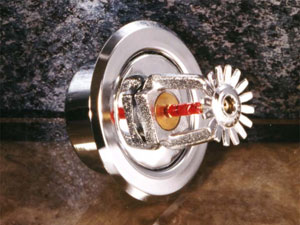 With a residential fire sprinkler system, your home is protected as if there were a firefighter on duty in each room for 24 hours a day, ready to stop any fire in its beginning stages with a minimal amount of water. Like any mechanical system, however, periodic maintenance is necessary to insure proper performance.
With a residential fire sprinkler system, your home is protected as if there were a firefighter on duty in each room for 24 hours a day, ready to stop any fire in its beginning stages with a minimal amount of water. Like any mechanical system, however, periodic maintenance is necessary to insure proper performance.
System Components
- Shut-Off Valve—The main water meter shutoff outside your house is the only valve that will shut off the water to your sprinkler system. The sprinkler system cannot be shut off independent of the house service.
- Riser—Commonly found in the garage, it should be labeled as such. It also may be located in a utility closet or wall cabinet.
- Gauge—Found with the riser, it records the static pressure of the system.
- Inspector Test Valve—Located on the wall of the house that is the furthest from the riser, it, too, should be labeled. It looks like a hose faucet without a handle.
- Bell(s)—In a visible location at the front or rear of a structure, there may be more than one bell and should be audible from all sleeping areas.
- Interior Alarm Device—Typically found in the hallway, this device is optional.
Did You Know?
- Many insurance companies offer discounts to homeowners whose homes have fire sprinkler systems. A fire sprinkler system will also increase the resale value of your home.
- Sprinklers rarely leak. They're tested at 175 psi (pounds per square inch) for 24 hours. Standard plumbing is only tested at 60 psi!
- Sprinklers activate individually; a fire will trigger the sprinkler head closest to it first. One sprinkler head is usually enough to contain a fire.
- Sprinkler heads are activated by heat only. Smoke without heat will not trigger a sprinkler.
- Sprinklers cause less damage than the fire itself. A sprinkler will control a fire in its early stages while using considerably less water than firefighters would.
Do's and Don'ts
- DO test your system monthly. If your system is monitored by an alarm service, be sure to notify their personnel before testing the system to prevent a false alarm. Open the test valve and listen for an alarm bell. Once the alarm sounds, turn off the valve. If the alarm bell does not sound, contact a qualified fire sprinkler contractor.
- DO know the location of the system shutoff valve. Be sure all other adult occupants are aware of its location.
- DO make certain the system control valve is open at all times.
- DO have your system extended if your home is enlarged or remodeled. Contact a licensed fire sprinkler contractor and make sure plans are submitted to the fire department as required to secure a permit.
- DO contact the fire department if your system ever activates (except when testing the system), even if the fire has apparently been extinguished.
- DON'T paint the sprinklers.
- DON'T damage the sprinklers.
- DON'T hang objects from the sprinklers.
- DON'T cover or obstruct the sprinklers.
- DON'T remove the sprinklers.
- DON'T turn off or disconnect the system.
- DON'T shut off the system in the event of a fire; the fire department will take care of it.
In the event of a fire, DO remain calm and leave your home immediately. Call 9-1-1 from a neighbor's house.
We hope that this information, provided by the National Fire Sprinkler Association, will help you to better understand your sprinkler system.
If you have any other questions, contact the Escondido Fire Department at 760 839-5400.